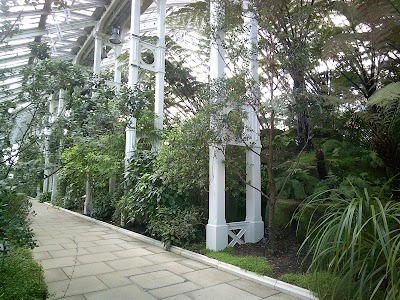This has been a Cucumber summer for me. It is the first time I have ever grown Cucumbers and I had no idea that Cucumbers could be so much fun or that baby Cucumbers could be so cute. I have two plants of the long skinny Japanese/Asian variety Cucumber and so far I have picked thirteen with a few more still coming. Growing vegetables is still a learning process for me as my kitchen container garden only got going after I retired and had the time to give it. I used to read gardening books for information but now it is Google and You Tube that we all turn to. Either way I am sure the learning process is good for my old brain as is the food grown.
 |
| Male flower with female attached on young cucumber fruit. |
From those sources I have learnt that Cucumbers are warm weather vegetables that have fast growing but short lives. One needs to make sure that you keep up with picking the fruit often and early to keep new ones growing. An unpicked, yellow, ripe Cucumber sends the message to the plant that its job of procreation is done and the plant will die. Another important fact is that Cucumbers need a lot of water and certainly should be checked every day. Mulching will help the plants not dry out so fast.
Cucumbers like rich, well drained soil. Compost is always good. There are bush and trellis growing types of plants. The bush ones are good for container growing but my vine ones are doing good with support. Any long strong stick laying around has been called to duty with string ties to help hold the vines on them.
 |
Young cucumber plant growing on a
trellis of sticks and the trunk of a
tall lau pele plant. |
Powdery mildew can be a problem so a trellis allows air to flow around the plant to help prevent this. Removing the lowest leaves and not watering the leaves, only the soil, (like you would with tomatoes) also helps. In Hawaii pickle worm can be a problem with Cucumbers too. Several times I have bought local Cucumbers at a store and found a larvae tube going through the fruit when I cut it open at home. Some people cover their Cucumbers with bags to protect them from this while on the vine. I have been wrapping mine with onion bag netting and so far have not had any problem.
 |
Cucumber wrapped in onion bag netting to keep away
the pickle worm bug. Plus the red netting helps for
easy finding of the fruit amongst the leaves. |
The Cucumber has distinctive male and female flowers. The first lot of flowers that show up are all big, yellow male flowers and it is suggested to remove those to give more energy to plant growth. The female flowers are not so showy but grow on an inch long prickly looking stem. If the female gets pollinated that stem grows into the Cucumber but will just wither and die if it does not. Within 5 days or so you will be able to twist the grown Cucumber off the vine as it seems to double in size every day. This whole process is what makes this plant so interesting. First thing every morning I have to go see what is happening on my two vines and find any fruit that is ready for picking. I also love showing my grandchildren the process and they get a mini lesson about plant sex life as part of it.
 |
Two male flowers on the left and a female flower on
the right showing the stem that grows into a
cucumber if the flower is pollinated. |
I grew my plants from seed in a small pot and then planted them up in two large 5 gallon pots which I keep covered in mulch. In the future, I think one plant at a time is enough for me, but I will try growing a replacement a few months later to keep my supply up. August heat has arrived and I am not sure how long these two plants will last into late summer. Some leafy vegetables are definitely wilting with the heat despite getting water. Will I be able to grow them in winter? It will be an ongoing Cucumber education.
 |
| My very first cucumbers! |
Meanwhile, I love eating Cucumbers. I grew up eating the occasional Cucumber salad or sandwich. I remember my father getting excited about growing a new white, round apple shaped Cucumber. My travels in the Middle East made me see Cucumbers in a new light. If you are living in hot desert countries like Egypt or Israel, Cucumbers become an extra source of cooling hydration. After all, they are 95% water. Cucumbers get served at almost every meal including breakfast. In Nepal street sellers would have long spears of cut Cucumbers to sell as refreshment along with other fruit. Although Cucumbers are not super high in nutrients, those that they do have are mostly in the skin. This is why I like the local Japanese cucumbers as they are very thin skinned and do not need to be peeled. I can happily eat Cucumber slices with salt as a side dish but for special meals I like making the rice vinegar based Japanese Namasu or the yogurt based Indian Raita. Of course there are also Cucumber pickles to consider.....especially if you have too many Cucumbers.
Aloha
P.S. November 2024
I saw these thin Japanese cucumbers on sticks for sale in Narita, Japan. A cooling treat for the many visitors visiting the big temple complex there. There are bags of ice on top of the cucumbers to keep them cold.
 |
| One for 200 yen.....about US $1.30 |

















































